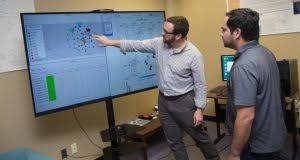
Oklahoma state seismologist Jake Walter and researchers at the Oklahoma Geological Survey used their time in the COVID-19 lockdowns to develop what they call cutting-edge earthquake detection technology.
The Oklahoma Geological Survey announced this week that Walter and others created machine learning or artificial intelligence to identify small earthquakes that would otherwise have been impossible to detect.
In place since early May 2020, this new software has allowed the OGS to identify twice as many earthquakes as would otherwise be reported by conventional techniques. All of the newly detected earthquakes are too small to be felt by people, generally less than M2.
With time during lockdown, Walter began a project of organizing his many computer codes, each with unique approaches for detecting and locating earthquakes. When running in tandem, the codes provide a wealth of raw data to better capture the microscopic movements of the earth. But Walter faced a problem. This data was too much for even a team of geoscientists to efficiently sift through.

“That’s when I realized we could leverage a machine-learning picker developed at the California Institute of Technology,” said Walter.
The CalTech machine learning picker was designed using millions of seismogram datasets. The picker “learned” what an earthquake, even a very small one, looks like. Able to sort through enormous amounts of data, it can immediately identify earthquakes in a waveform. Walter and his team can feed their data into the picker and get picks for individual stations, of which OGS operates more than 90 throughout the state. Next, they added event association and other tools onto the picker that can output a full earthquake catalog for a provided dataset.
The result is a fully operational software package that analyzes data and detects earthquakes. It is significantly more sensitive than its predecessors and operates fairly easily with a few changes to the code.
This new system has not replaced the OGS real-time earthquake detection system that monitors and reports on all earthquake activity in the state. Rather, the two detection systems are running in parallel, and the team is now identifying smaller events thanks to the new software.
Walter’s software is believed to be the first implementation of machine-learning technology by a regional seismic network for routine earthquake identification and alerting. The software package is open source, meaning other geoscientists can use it and even adapt it for their own needs.
“We’re already hearing from fellow researchers from around the world who are using our software on their projects,” said Walter.
The team’s findings were just published in the prestigious geoscience journal, Seismological Research Letters. Walter hopes that use of his software will continue the advancement of understanding of seismicity around the world.
Source: Oklahoma Geological Survey





